TUTOR1 STUDYHUB
BEST RELIABLE AND TRUSTWORTHY STUDYMATERIALS
- 857
- 0
- 0
Community
- Followers
- Following
1 Reviews received
857 items
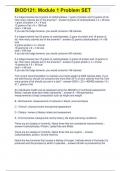
BIOD121: Module 1 Problem SET
BIOD121: Module 1 Problem SET If a fudge brownie has 9 grams of carbohydrates, 1 gram of protein and 12 grams of fat. How many calories are in the brownie? - answer-9 grams of carbohydrates x 4 = 36 kcal 1 gram of protein x 4 = 4 kcal 12 grams of fat x 9 = 108 kcal total = 148 kcal If you ate the fudge brownie, you would consume 148 calories. If a fudge brownie has 22 grams of carbohydrates, 2 gram of protein and 16 grams of fat. How many calories are in the brownie? - answer-22 grams carbohyd...
- Exam (elaborations)
- • 3 pages •
BIOD121: Module 1 Problem SET If a fudge brownie has 9 grams of carbohydrates, 1 gram of protein and 12 grams of fat. How many calories are in the brownie? - answer-9 grams of carbohydrates x 4 = 36 kcal 1 gram of protein x 4 = 4 kcal 12 grams of fat x 9 = 108 kcal total = 148 kcal If you ate the fudge brownie, you would consume 148 calories. If a fudge brownie has 22 grams of carbohydrates, 2 gram of protein and 16 grams of fat. How many calories are in the brownie? - answer-22 grams carbohyd...
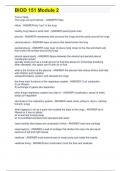
BIOD 151 Module 2 True or false
BIOD 151 Module 2 True or false. The lungs are symmetrical. - ANSWER-False Hilum - ANSWER-the "root" of the lung healthy lung tissue is what color - ANSWER-peachy/pink color pleurae - ANSWER-membranes that surround the lungs and the cavity around the lungs visceral pleura - ANSWER-layer of pleura
- Exam (elaborations)
- • 8 pages •
BIOD 151 Module 2 True or false. The lungs are symmetrical. - ANSWER-False Hilum - ANSWER-the "root" of the lung healthy lung tissue is what color - ANSWER-peachy/pink color pleurae - ANSWER-membranes that surround the lungs and the cavity around the lungs visceral pleura - ANSWER-layer of pleura
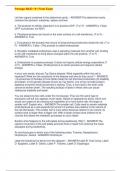
Portage BIOD 151 Final Exam
Portage BIOD 151 Final Exam List two organs contained in the abdominal cavity. - ANSWER-The abdominal cavity contains the stomach, intestines, spleen and liver a. The purpose of cellular respiration is to produce ADP. (T or F) - ANSWER-a. False- (ATP is produced, not ADP) b. Peripheral proteins are found on the outer surface of a cell membrane. (T or F) - ANSWER-b. True c. Exocytosis is the process that occurs to bring biomacromolecules inside the cell. (T or F) - ANSWER-c. False- (This proc...
- Exam (elaborations)
- • 3 pages •
Portage BIOD 151 Final Exam List two organs contained in the abdominal cavity. - ANSWER-The abdominal cavity contains the stomach, intestines, spleen and liver a. The purpose of cellular respiration is to produce ADP. (T or F) - ANSWER-a. False- (ATP is produced, not ADP) b. Peripheral proteins are found on the outer surface of a cell membrane. (T or F) - ANSWER-b. True c. Exocytosis is the process that occurs to bring biomacromolecules inside the cell. (T or F) - ANSWER-c. False- (This proc...
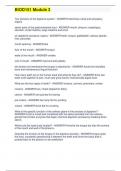
BIOD151 Module 3
BIOD151 Module 3 Two divisions of the digestive system - ANSWER-alimentary canal and accessory organs seven parts of the gastrointestinal tract - ANSWER-mouth, pharynx, esophagus, stomach, small intestine, large intestine and anus six digestive accessory organs - ANSWER-teeth, tongue, gallbladder, salivary glands, liver, pancreas mouth opening - ANSWER-lips floor of the mouth - ANSWER-tongue walls of the mouth - ANSWER-cheeks roof of mouth - ANSWER-hard and soft palates
- Exam (elaborations)
- • 6 pages •
BIOD151 Module 3 Two divisions of the digestive system - ANSWER-alimentary canal and accessory organs seven parts of the gastrointestinal tract - ANSWER-mouth, pharynx, esophagus, stomach, small intestine, large intestine and anus six digestive accessory organs - ANSWER-teeth, tongue, gallbladder, salivary glands, liver, pancreas mouth opening - ANSWER-lips floor of the mouth - ANSWER-tongue walls of the mouth - ANSWER-cheeks roof of mouth - ANSWER-hard and soft palates
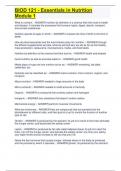
BIOD 121 - Essentials in Nutrition Module 1
BIOD 121 - Essentials in Nutrition Module 1 What is nutrition: - ANSWER-nutrition by definition is a science that links food to health and disease. It includes the processes that humans ingest, digest, absorb, transport, and excrete substances Nutrition spands all ages in which: - ANSWER-it impacts the time of birth to the time of death How do pharmaceuticals and the food industry play into nutrition: - ANSWER-through the different supplements we take, what we eat and why we eat as far as fo...
- Exam (elaborations)
- • 7 pages •
BIOD 121 - Essentials in Nutrition Module 1 What is nutrition: - ANSWER-nutrition by definition is a science that links food to health and disease. It includes the processes that humans ingest, digest, absorb, transport, and excrete substances Nutrition spands all ages in which: - ANSWER-it impacts the time of birth to the time of death How do pharmaceuticals and the food industry play into nutrition: - ANSWER-through the different supplements we take, what we eat and why we eat as far as fo...

Module 1 Review Quiz
Module 1 Review Quiz (16 questions), BIOD 171, Portage Learning Microbiology is the study of what? - ANSWER-My answer: Microbiology is the study of microorganisms and their biological processes at what is called the "micro" or "microscopic" level. Answer Key: Microbiology is the study of microbes (microorganisms and viruses) and their biological processes. What is the smallest biological unit of life? - ANSWER-the cell What is a macromolecule? - ANSWER-My answer: Macromolecules are large...
- Exam (elaborations)
- • 4 pages •
Module 1 Review Quiz (16 questions), BIOD 171, Portage Learning Microbiology is the study of what? - ANSWER-My answer: Microbiology is the study of microorganisms and their biological processes at what is called the "micro" or "microscopic" level. Answer Key: Microbiology is the study of microbes (microorganisms and viruses) and their biological processes. What is the smallest biological unit of life? - ANSWER-the cell What is a macromolecule? - ANSWER-My answer: Macromolecules are large...
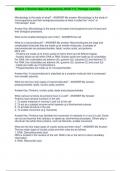
Module 1 Review Quiz
Module 1 Review Quiz (16 questions), BIOD 171, Portage Learning Microbiology is the study of what? - ANSWER-My answer: Microbiology is the study of microorganisms and their biological processes at what is called the "micro" or "microscopic" level. Answer Key: Microbiology is the study of microbes (microorganisms and viruses) and their biological processes. What is the smallest biological unit of life? - ANSWER-the cell What is a macromolecule? - ANSWER-My answer: Macromolecules are large...
- Exam (elaborations)
- • 4 pages •
Module 1 Review Quiz (16 questions), BIOD 171, Portage Learning Microbiology is the study of what? - ANSWER-My answer: Microbiology is the study of microorganisms and their biological processes at what is called the "micro" or "microscopic" level. Answer Key: Microbiology is the study of microbes (microorganisms and viruses) and their biological processes. What is the smallest biological unit of life? - ANSWER-the cell What is a macromolecule? - ANSWER-My answer: Macromolecules are large...

Module 1 Review Quiz
Module 1 Review Quiz (16 questions), BIOD 171, Portage Learning Microbiology is the study of what? - ANSWER-My answer: Microbiology is the study of microorganisms and their biological processes at what is called the "micro" or "microscopic" level. Answer Key: Microbiology is the study of microbes (microorganisms and viruses) and their biological processes. What is the smallest biological unit of life? - ANSWER-the cell What is a macromolecule? - ANSWER-My answer: Macromolecules are large...
- Exam (elaborations)
- • 4 pages •
Module 1 Review Quiz (16 questions), BIOD 171, Portage Learning Microbiology is the study of what? - ANSWER-My answer: Microbiology is the study of microorganisms and their biological processes at what is called the "micro" or "microscopic" level. Answer Key: Microbiology is the study of microbes (microorganisms and viruses) and their biological processes. What is the smallest biological unit of life? - ANSWER-the cell What is a macromolecule? - ANSWER-My answer: Macromolecules are large...

BIOD Exam
BIOD Exam 2 What are the 7 characteristics of life? - CORRECT-1. Order 2. Regulation 3. Energy Processing 4. Evolutionary Adaptation 5. Response to the Environment 6. Reproduction 7. Growth and Development
- Exam (elaborations)
- • 6 pages •
BIOD Exam 2 What are the 7 characteristics of life? - CORRECT-1. Order 2. Regulation 3. Energy Processing 4. Evolutionary Adaptation 5. Response to the Environment 6. Reproduction 7. Growth and Development
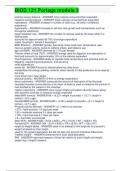
BIOD 121 Portage module 3 positive energy balance
BIOD 121 Portage module 3 positive energy balance - ANSWER-more calories consumed than expended negative energy balance - ANSWER-fewer calories consumed than expended hyperplasia - ANSWER-increase in number of cells (e.g., fat cells in childhood, pregnancy) hypertrophy - ANSWER-increase in cell size (low growth and maintenance, such as throughout adulthood) basal metabolic rate - ANSWER-the number of calories used by the body while in a fasting state accounts for approximately 60-70% of energy ...
- Exam (elaborations)
- • 4 pages •
BIOD 121 Portage module 3 positive energy balance - ANSWER-more calories consumed than expended negative energy balance - ANSWER-fewer calories consumed than expended hyperplasia - ANSWER-increase in number of cells (e.g., fat cells in childhood, pregnancy) hypertrophy - ANSWER-increase in cell size (low growth and maintenance, such as throughout adulthood) basal metabolic rate - ANSWER-the number of calories used by the body while in a fasting state accounts for approximately 60-70% of energy ...

PN HESI EXIT EXAM 2023/2024 LATEST VERSION QUESTIONS AND ANSWERS BEST GRADED A+ ASSURED SUCCESS FOR NURSING 1)
BEST SELLER